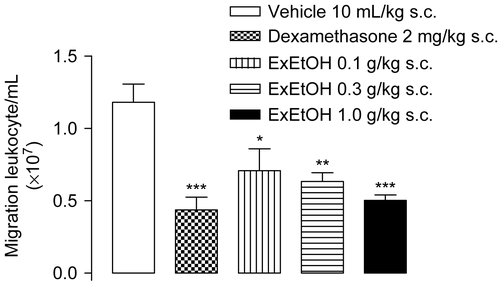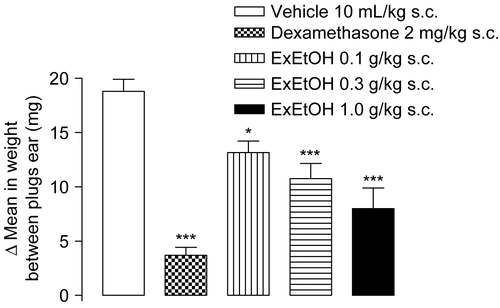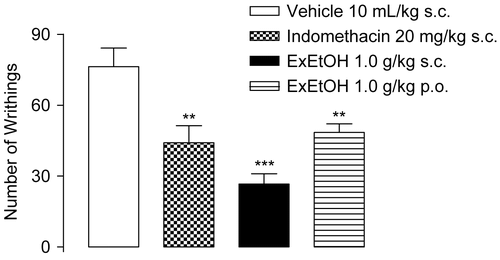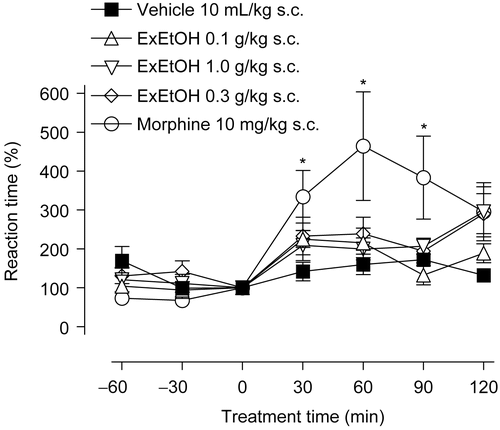Abstract
The tail flick, the acetic acid writhing, the croton oil-induced mouse ear edema, and carrageenan-induced peritonitis tests were used to study the anti-inflammatory effects of the alcohol extract from Pterodon emarginatus Vogel. (Leguminosae/Fabaceae) stem bark. The alcohol extract caused inhibition of acetic acid-induced abdominal writhing, reducing the number of leukocytes (x 107) per mL of peritoneal wash and ear edema formation. The results suggest that Pterodon emarginatus stem bark contains compounds with analgesic and anti-inflammatory actions.
Introduction
The Pterodon emarginatus Vogel. (Leguminosae/Fabaceae), known as sucupira branca, is a native species widely distributed over central Brazil (Goiás, Minas Gerais and São Paulo). It is a tree 5–15 m in height, whose wood is used as timber. The decoction of its stem bark and seeds is used in folk medicine against various diseases (CitationAgra et al., 2007; CitationLima et al., 2006).
Alcohol extracts from the seeds of Pterodon emarginatus are used in folk medicine for rheumatism, sore throats, depurative, tonic and analgesic preparations (CitationBelinelo et al., 2002). Moreover, “sucupira branca”, vulgar denomination of the cited species above, is also used for gynecological infections (CitationAlmeida & Gottlieb, 1975).
The oil from the fruits and seeds of Pterodon species is reputed to inhibit skin penetration of the cercaria of Schistosoma mansoni (CitationDemuner et al., 1996) and anti-inflammatory activity (CitationFalcão et al., 2005; CitationCarvalho et al., 1999). The characteristic constituents of this genus are the linear and tetracyclic diterpenoids possessing either vinhaticane or vouacapane skeletons (CitationCampos et al., 1994). CitationMarques et al. (1998) reported the isolation of isoflavones, p-methoxybenzoic acid, lupeol and betulin from sapwood and the heartwood of Pterodon polygalaeflorus Benth.
Wood, leaves, roots, stem bark and the seeds of Pterodon polygalaeflorus, are used ethnobotanically as anti-rheumatic, in the treatment of throat infections (CitationAgra et al., 2007; CitationLima et al., 2006).
Based on the reported popular use of Pterodon emarginatus, the present study evaluated the analgesic, anti-inflammatory, and other general effects of alcohol extracts of the plant stem bark.
Materials and methods
Botanical material
The stem bark of Pterodon emarginatus was collected from plants in their natural habitat in the Cerrado region of Bela Vista (847 m, 17°02’1,1” S/48°49’0,3” W), Goiás, Brazil (September 2003). Samples were authenticated by José Realino de Paula and a voucher specimen (number UFG–27155) was deposited at the herbarium of the Universidade Federal de Goiás (UFG), Goiás, Brazil. The stem bark was cut into small pieces, dried at 30–40ºC for 48 h, and crushed to a powder. The alcohol extract (ExEtOH) was obtained from the powdered botanical material (900 g) by maceration in 4.5 L of cold ethanol (95% V/V), with occasional agitation, for 72 h, followed by filtration. The filtrate was concentrated under reduced pressure and dried in a rotavapor. The extraction procedure gave 270 g of alcohol extract (yield = 30%). At the time of use, the extract was dissolved in distilled water at the required concentrations.
Animals
Male Swiss albino mice weighing approximately 30 g and male Wistar rats weighing 200–250 g, from the Central Animal House of the Universidade Federal de Goiás (UFG), were used in this study. The animals received food and water ad libitum and were maintained in a room with light and temperature regulation, in accordance with the Guide for the Care and Use of Laboratory Animals, National Research Council, USA (1996). Animals were acclimatized for 4 days before the beginning of the experiments.
Drugs and dosage
The following drugs were used: 1.2% solution of acetic acid (Merck; 10 mL/kg), 1% solution of carrageenan (Sigma; 0.25 mL/animal), croton oil (Prodome), dexamethasone (Decadron-Prodome; 2 mg/kg), morphine (Roche, Switzerland; 10 mg/kg), indomethacin (Sigma; 20 mg/kg); vehicle (water, 10 mL/kg), crude alcohol extract (ExEtOH; 0.1, 0.3, and 1.0 g/kg). All other chemicals were from Merck (Brazil). All drugs and ExEtOH were dissolved in water.
Effects on general behavior
The effects of the extract on spontaneous behavior of mice and rats were analyzed by the Hippocratic procedure (CitationMalone, 1977). The ExEtOH or vehicle was administered to groups (n = 4) of the animals at doses 0.01 to 2.0 g/kg and 10 mL/kg, respectively (per oral (p.o.), intraperitoneal (i.p.) and subcutaneous (s.c.)). The animals were kept under observation for seven days after drug administration.
Acetic acid-induced abdominal writhing
The response to an intraperitoneal injection of acetic acid solution, i.p., the contractions of the abdominal muscles and stretching of hind limbs, was studied according to procedures described by CitationHendershot and Forsaith (1959). Groups of mice (n = 12) were treated subcutaneously with indomethacin (20 mg/kg), ExEtOH (1.0 g/kg), or vehicle (10 mL/kg) and orally with ExEtOH (1.0 g/kg), 45 min before the administration of a 1.2% acetic acid solution (10 mL/kg, i.p.). The number of abdominal writhings produced in each group for the subsequent 30 min was counted and the results were expressed as total number of writhings. A significant reduction in the number of writhing movements in the groups treated with the ExEtOH compared with control was considered to be a positive analgesic response.
Tail flick test
The reaction of mice to thermal stimulation of the tail tip by immersion in water maintained at 56°C was recorded at 60 and 30 min before, and 0, 30, 60, 90, and 120 min after treatment. The mice were divided into five experimental groups (n = 6) consisting of animals treated subcutaneously with vehicle (10 mL/kg), ExEtOH (0.1, 0.3, or 1.0 g/kg) or morphine (10 mg/kg). Analgesia was expressed as mean ± SEM reaction time(s) relative to time zero, according to the technique of CitationJanssen et al. (1963), as modified by CitationGrotto and Sulman (1967).
Carrageenan-induced peritonitis
Experimental groups (n = 7) were treated subcutaneous with vehicle (10 mL/kg), dexamethasone (2 mg/kg), or ExEtOH (0.1, 0.3, 1.0 g/kg) followed by 1% carrageenan (0.25 mL, i.p.) 60 min later. Four hours after carrageenan administration, mice were killed and 2 mL of modified PBS (heparin, 10 IU/mL) was injected into the peritoneal cavity. Total cell counts in the lavage fluid were performed using a Neubauer chamber as described by CitationFerrándiz and Alcaraz (1991). The results were expressed as means ± SEM of the numbers of total leukocytes (3 107) per mL of peritoneal wash in relation to the control group.
Croton oil-induced ear edema test
Animals were treated with vehicle (control, 10 mL/kg; s.c.), ExEtOH (0.1, 0.3, or 1.0 g/kg; s.c.) or dexamethasone (2 mg/kg; s.c.) and 60 min later, cutaneous inflammation was induced by applying 25 μL of a solution of croton oil in acetone (2.5% v/v) to the inner surface of the right ear of mice. The same volume of acetone was applied to the left ear by the method of CitationZanini et al. (1992). Four hours after treatment, mice were killed by cervical dislocation and a plug (6 mm in diameter) was taken from both treated and untreated ears with a punch. The inflammatory response (edema) was monitored by measuring the differences in weight (mg) between the two plugs.
Statistical analysis
Data were analyzed by one-way ANOVA followed by the Student´s t-test for unpaired samples (CitationSokal & Rohlf, 1981). The data were reported as mean ± SEM. P values less than 0.05 (p <0.05) were considered to be significant.
Results
Effects on gross behavior
In the general test of pharmacological activity the animals exhibited analgesia proportionally to the doses applied. The highest dose of ExEtOH i.p. caused death after 1 h of the treatment.
Acetic acid-induced abdominal writhing
The ExEtOH (1.0 g/kg) p.o. or i.p. produced a significant, inhibition (48.5 ± 3.5 (p.o.), 26.6 ± 4.4 (s.c.), respectively) of the acetic acid-induced abdominal writhings in relation to the control value (76.3 ± 7.8, ).
Tail flick test
The ExEtOH was inactive in the tail flick model of analgesia even at the highest dose tested (1.0 g/kg). Morphine, used as the reference drug, produced an antinociceptive effect at all observation times when compared to control values ().
Carrageenan-induced peritonitis
Pretreatment with ExEtOH (0.1, 0.3, and 1.0 g/kg) significantly reduced the total leukocyte migration to the peritoneum induced by carrageenan compared to the control group. ExEtOH administered subcutaneously caused inhibition of total leukocyte migration from (0.70 ± 1.5, 0.63 ± 0.61 and 0.50 ± 0.37, respectively) in relation to the control (1.18 ± 1.2, ).
Figure 3. Effect of the previous treatment with alcohol extract of Pterodon emarginatus stem bark (ExEtOH 0.1, 0.3, or 1.0 g/kg, s.c) on total leukocyte migration. The vertical bars represent the means ± SEM. Dexamethasone (2 mg/kg s.c) was used as positive control. *p <0.05, **p <0.01 and ***p <0.001.

Croton oil-induced ear edema test
The ExEtOH (0.1, 0.3, and 1.0 g/kg) produced a significant, inhibition the croton oil-induced ear edema (13.1 ± 1.0, 10.7 ± 1.4 and 8.0 ± 1.9, respectively) in relation to the control (18.7 ± 1.1 mg, ).
Figure 4. Effect of the previous treatment with alcohol extract of Pterodon emarginatus stem bark (ExEtOH 0.1, 0.3, or 1.0 g/kg, s.c) on croton oil-induced ear edema in mice. The vertical bars indicate the means ± SEM of differences in weight between right and left ear plugs. Dexamethasone (2.0 mg/kg, s.c) was used as a positive control. *p <0.05 and ***p <0.001.

Discussion and conclusions
The analgesia observed in the general test of pharmacological activity indicated the presence of compounds with analgesic action in ExEtOH. Two different analgesia models have been used to evaluate the antinociceptive effect of the ExEtOH: the tail flick test and the acetic acid-induced writhing test in mice. The ExEtOH had no effect in the tail flick test, but inhibited significantly writhing movements.
The acetic acid introduced by the intraperitoneal route indirectly acts to cause the release of involved endogenous mediators in the modulation of the nociceptive action, in which we can cite bradykinin, serotonin, histamine, PGs, among others, that would be responsible for stimulation of nociceptive neurons and consequently the induced pain (CitationWhittle, 1964; CitationBerkenkopf & Weichman, 1988). The model of acetic acid-induced abdominal writhing is relatively simple, with low specificity but good sensitivity to several drugs that exert analgesic activity, steroidal and non-steroidal anti-inflammatory agents, as well as central and peripheral acting opioid analgesics.
The tail flick test is a commonly used method to study the effects of analgesic drugs similar to morphine, as it is for drugs that act on the CNS (CitationCarter, 1991). The results show the morphine produced analgesia. However, the ExEtOH did not have an antinociceptive effect, even at the highest dose tested (1.0 g/kg), suggesting that the ExEtOH does not contain compounds with central analgesic properties.
Although the ExEtOH doesn’t contain compounds with central analgesic activity, inhibition of the number of the writhings in mice suggests the extract contains compounds with peripheral analgesic and/or anti-inflammatory activity. In an inflammatory process, a series of cellular and vascular events occur, where some mediators derived from cells and the plasmatic activation produce some signals characteristic of inflammation. Vascular alterations immediately occur after the beginning of the inflammation, prevailing for some hours. They consist of vasodilation, increase of sanguine flow, increase of the vascular permeability and plasmatic exudation (CitationWilliams, 1983). Therefore, we studied the ability of the ExEtOH to inhibit the carrageenan-induced peritonitis test, where the ExEtOH showed anti-inflammatory activity, possibly explained by the interference of chemotactic mechanisms. This pharmacologic model allows the quantification of leukocyte migration to the peritoneal cavity under the action of chemotactic agents, mainly LTs and ILs. The carrageenan induces an acute inflammation involving sequential release of some pro-inflammatory mediators, mainly the histamine, kinins, serotonin, thromboxanes and prostaglandins (CitationDi Rosa et al., 1971; CitationDamas et al., 1990). In the carrageenan-induced peritonitis in rats, the antiexudative effect provoked for the non-steroidal anti-inflammatory could be associated with PGE2 reduction, and reduction of the activity of phospholipase A2 enzyme, while the anti-inflammatory activity of the steroidal anti-inflammatory would be explained by reduction of leukocyte migration (CitationMikami & Miyasaka, 1983). In conclusion, this work demonstrated that alcohol extracts from stem bark of Pterodon emarginatus develop anti-inflammatory and analgesic activities, which may support the popular use of this plant in analgesic preparations. Further studies are currently underway in our laboratory to isolate and identify the compounds responsible for these activities.
Acknowledgements
The authors are grateful to Ekaterina A. F. B. Rivera and Jackson Nascimento de Lima for technical assistance. Thanks are also due to CAPES, CNPq, FUNAPE/UFG for financial support.
Declaration of interest: The authors report no conflicts of interest. The authors alone are responsible for the content and writing of the paper.
References
- Agra MF, Freitas PF, Barbosa-Filho JM (2007): Synopsis of the plants known as medicinal and poisonous in Northeast of Brazil. Rev Bras Farmacogn 17: 114–140.
- Almeida MEL, Gottlieb OR (1975): Further isoflavones from Pterodon appariciori. Phytochemistry 14: 2716.
- Belinelo VJ, Reis GT, Stefani GM, Ferreira-Alves DL, Piló-Veloso D (2002): Synthesis of 6α,7β-dihydroxyvouacapan-17β-oic acid derivatives. Part IV: Mannich base derivatives and its activities on the electrically stimulated guinea-pig ileum preparation. J Braz Chem Soc 13: 830–837.
- Berkenkopf JW, Weichman BM (1988): Production of prostacyclin in mice following intraperitoneal injection of acetic acid, phenylbenzoquinone and zymosan: Its role in the writhing response. Prostaglandins 36: 693–709.
- Campos AM, Silveira ER, Braz-Filho R, Texeira TC (1994): Diterpenoids from Pterodon polygalaeflorus. Phytochemistry 36: 403–406.
- Carter RB (1991): Differentiating analgesic and non-analgesic drug activities on rat hot plate: Effect of behavioral endpoint. Pain 47: 211–220.
- Carvalho JCT, Sertié JAA, Barbosa MVJ, Patrício KCM, Caputo LRG, Sarti SJ, Ferreira LP, Bastos JK (1999): Anti-inflammatory activity of the crude extract from the fruits of Pterodon emarginatus Vog. J Ethnopharmacol 64: 127–133.
- Damas J, Bourdon V, Remacle-Volon G, Adam A (1990): Kinins and peritoneal exudates induced by carrageenin and zymosan in rats. Br J Pharmacol 101: 418–422.
- Demuner AJ, Barbosa LCA, Veloso DP, Alves DLF, Howarth WO (1996): Structure and plant growth regulatory activity of new diterpenes from Pterodon polygalaeflorus. J Nat Prod 59: 770–772.
- Di Rosa M, Giroud JP, Willoughby DA (1971): Studies of the mediators of acute inflammatory response induced in rats in different sites by carrageenin and turpentine. J Phathol 104: 15–29.
- Falcão HS, Lima IO, Santos VL, Dantas HF, Diniz MFFM, Barbosa-Filho JM, Batista LM (2005): Review of the plants with anti-inflammatory activity studied in Brazil. Rev Bras Farmacogn 15: 381–391.
- Ferrándiz ML, Alcaraz MJ (1991): Antiinflammatory activity and inhibition of arachidonic acid metabolism by flavonoids. Agents and Actions 32: 283–288.
- Grotto M, Sulman FG (1967): Modified receptacle method for animal analgesimetry. Arch Int Pharmacodyn 165: 152–159.
- Hendershot LC, Forsaith J (1959): Antagonism of the frequency of phenylquinone-induced writhing in the mouse by weak analgesics and nonanalgesics. J Pharmacol Exp Ther 125: 237–240.
- Janssen PAJ, Niemegeers CJE, Dony JGH (1963): The inhibitory effect of fentanyl and other morphine-like analgesics on the warm water induced tail withdrawal reflex in rats. Arzneim Forsch/Drug Res 6: 502–507.
- Lima MRF, Ximenes ECPA, Luna JS, Sant’Ana AEG (2006): The antibiotic activity of some Brazilian medicinal plants. Rev Bras Farmacogn 16: 300–306.
- Malone MH (1977): Pharmacological approaches to natural product screening and evaluation. In: Wagner H, Wolf P, New Natural Products and Plant Drugs with Pharmacological, Biological or Therapeutic Activity. Springer Verlag: Berlin, pp. 23–53.
- Marques DD, Machado MIL, Carvalho MG, Meleira LAC, Braz-Filho R (1998): Isoflavonoids and triterpenoids isolated from Pterodon polygalaeflorus. J Braz Chem Soc 9: 295–301.
- Mikami T, Miyasaka K (1983): Effects of several anti-inflammatory drugs on the various parameters involved in the inflammatory response in rat carrageenin-induced pleurisy. Eur J Pharmacol 95: 1–12.
- Sokal RR, Rohlf FJ (1981): Biometry: The Principles and Practice of Statistics in Biological Research. New York, WH Feeman, p. 859.
- Whittle BA (1964): Release of a kinin by intraperitoneal injection of chemical agents in mice. Int J Neuropharmacol 3: 369–378.
- Williams TJ (1983): Interactions between prostaglandins, leukotrienes and other mediators of inflammation. Br Med Bull 39: 239–242.
- Zanini JC Jr, Medeiros YS, Cruz AB, Yunes RRA, Calixto JB (1992): Action of compounds from Mandevilla velutina on croton oil-induced ear oedema in mice. A comparative study with steroidal and nonsteroidal antiinflammatory drugs. Phytother Res 6: 1–5.


